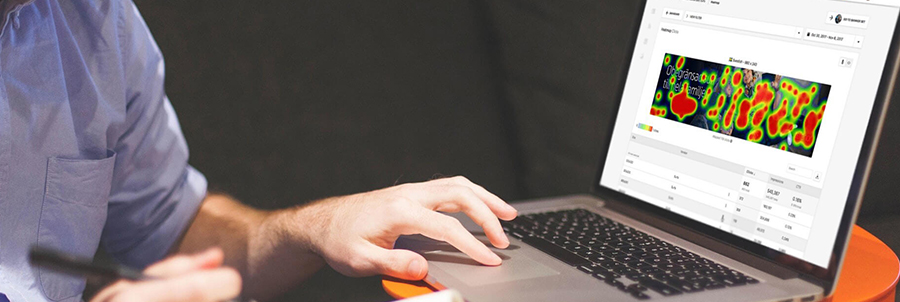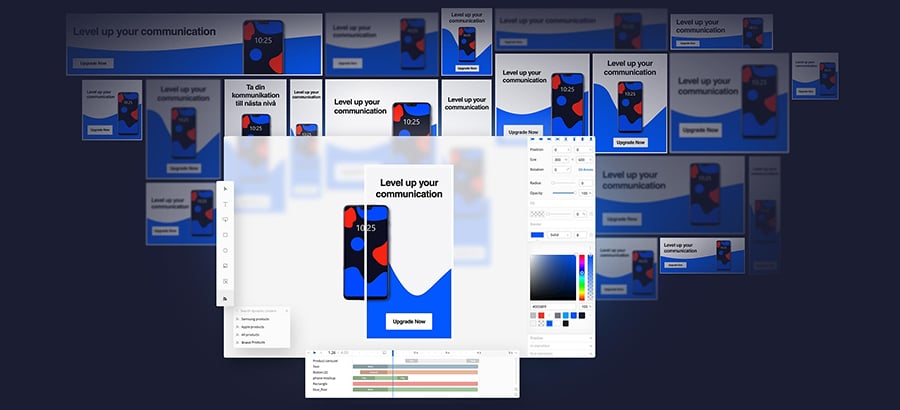
Display advertising CTRs and what these mean for your industry
Are you living the online marketer’s dream? High click-through rates from your target market and a steady flow of conversions that leave your competitors in the dust. Of course, it’s a big leap from creating your display ads to achieving those all-important click-through rates and conversions.
Impressions and click-through rates are two of the most common metrics to measure display advertising success. The total number of impressions reflects how many times your banner has been served but not always clicked – or even seen.
Ads can be shown to the same user more than once, and plenty of people will scroll by without paying any attention.
Despite these limitations, most marketers choose to pay for ad campaigns per impression because the statistics reflect brand awareness and visibility. While impressions can give you a general overview of your ad’s reach, you should combine them with other metrics to draw more reliable conclusions.
Display ads CTR in 2022
Average click-through rate (CTR) is a more tangible metric.
They measure the number of clicks on your display ad but don’t necessarily result in a higher conversion rate. Very few people click on display ads, and those that do won’t usually take action while there. This is why combining a display ad’s CTR with impressions gives you a clearer picture of your banner ad’s performance and how to benchmark this.
Our most recent 2022 display data analysis, gathering data from Bannerflow’s platform, trawled through results from over 200 billion impressions. The findings showed notable variations in CTRs across different verticals, including:
- Financial services
- Entertainment industry
- Travel
- iGaming
This guide will explore online ad performance benchmarks by industry, ad format, ad position, and channel. It will also discuss how to set a baseline CTR for your display ad.
What is a good CTR for display ads?
An average display ad CTR hovers at around 0.1%, but the higher CTR, the better.
The latest data gathered from Bannerflow’s platform evidence the current average CTR for feeded display ads (personalised ads) in 2022 sits at around 2.30% higher than non-feed ads. That’s up from 1.68% higher in 2021.
The latest statistics also include an increase in feeded impressions, which have jumped from 17% to 18%.
It clearly pays to personalise your ads.
Average click-through rate for feeded vs non-feeded ads
Non-personalised ads use geo-targeting and broad contextual information rather than a user’s past behaviour. These ads are randomly selected according to search terms and the subject matter of the host website. While they can be effective up to a certain point, you can’t control who sees non-personalised ads, so they might not reach your target audience.
Users are more likely to interact with relevant display ads. Feed advertisements enable a website to create dynamic displays based on the website content or the products users have previously viewed.
Feed banners enable a high degree of personalisation. They keep your display ads dynamic, fresh, and relevant by displaying live data and updates from a data source. You can integrate different variables into feeds, including everything from the latest exchange rates to stock information or even changes in the weather.
While these statistics are a general reference point, they are only part of the whole picture. The average click-through rate varies significantly depending on the industry, and we’ll cover those differences below.
Industry-specific CTR trends in 2022
The average click-through rate for feeded display ads is 2.30% higher than non-feeded, but that data point can be misleading.
In the finance sector, you can expect average feeded CTRs to have more than doubled in the past few years, sitting 117.5% higher than non-feeded CTRs. On the other hand, iGaming has seen far less dramatic gains, but there is still a notable trend towards personalised ads.
You can use this data as a reference point of industry benchmarks to help you identify how to budget for ads and gain a competitive advantage. Aim to maintain an average click-through rate equal to or slightly higher than your industry’s standard CTR.
Display ads CTRs for Financial services
Financial services use feed ads for their display advertising to target investors and new customers. The data suggest that personalised ads are highly effective at attracting their intended market, with a 117,5% increase in feed ads CTR compared to no feed.
Imagine how much time the marketing department of finance organisations saves by personalising their display ads. Interestingly, feed impressions have stayed relatively consistent over the past five years, while the feeded CTR has jumped up to 0.35% in 2022.
Display ads CTRs for Entertainment
The entertainment industry has seen a massive shift to in-home entertainment since the Covid-19 pandemic began. The CTR for entertainment display ads reflects these changes, with a 90.6% increase in the last two years. Display ads’ video and animation production capabilities are perfect for entertainment brands looking to engage users.
Our research shows that using video in ads resulted in 85% more click-throughs during 2021 compared to static ads. Data feeds account for 10% of impressions for entertainment ads. While that’s a slight fall from last year’s 18%, it’s still a trend to keep in mind as it’s still higher than the 1% of the pre-pandemic years.
Display ads CTRs for iGaming
iGaming is another rapidly changing industry that has been affected by the pandemic. In-person gambling was the foundation of the industry before 2020, when shutdowns and restrictions forced much of the industry online – including advertising.
Our data shows a 9% uptick in personalised (feeded) iGaming CTR in 2021. iGaming was an early adopter of data feeds for up-to-date betting odds, and it has maintained a consistent number of impressions. Most notably, we discovered the trend for CTR and feed impressions to rise in tandem with key events, such as Euro 2020.
Display ads CTRs for Travel
The travel industry was hit hardest in the past few years, but fortunately, it has already picked up. This year, the sky’s the limit with click-through rates for feed ads. Travel brands use data feeds to display selected travel products and offers and retarget potential customers who have left their websites.
They’ve increased by almost 50% compared to non-personalised ads. In contrast, feed impressions dropped significantly from 30% in 2020 to 5% in 2021 and only increased by 1% in 2022. This combination of high CTR with a low number of impressions suggests a positive trend in tightening up travel display ads, so they are relevant.
So, personalised ads perform well even though fewer people see them.
Display ads CTRs In Other Industries
Feed ads are also shining in the categories of industries not highlighted above. The average CTR for display ads is 10.4% higher compared to no-feed ads. A year ago, the CTR rate was -1.70%, meaning personalised ads have improved. The percentage of feed impressions is at 43% in 2022.
In 2018, impressions of feed ads were only 10%, and they’ve steadily grown over the last four years. So, the signs point to personalised, dynamic ads outperforming standard display ads across all industries.
How to improve your industry’s average CTR for display ads
Monitoring your CTR can help you determine – and improve – the quality of your imagery, copy, positioning, and keywords. Personalised ads help you serve the right viewer at the right time, wherever they are.
Before you do anything else to improve your banner ad’s CTR, ensure you use high-quality and relevant visuals. All ads should display your logo, colours matching your brand identity and text contrasting with the background. Also, create mobile-friendly ads since they have high viewability rates.
Once these fundamentals are in place, you’re ready for our tips to optimise your ad for even more clicks.
1. Use feeds to make your ads dynamic
Personalise ad templates according to the individual user’s data to make ads more welcome and relevant. Dynamic banners can change copy, imagery, CTA and real-time data, altering campaigns to suit everything from the local weather to the time of day.
Dynamic Creative Optimisation (DCO) can be simple or sophisticated. For example, some iGaming banners provide real-time betting odds, while others let you fill out a betting slip within the banner. Interactive ads stand out from static displays and encourage engagement. And don’t forget to schedule campaigns alongside key dates and events, such as Black Friday and Christmas.
2. Use the contextual targeting
Contextual advertising is simple but effective as it places the most relevant ads within the right context. The beauty is that your audience will be more interested in your ad based on the context and quality of the website they are visiting. For example, a wallpaper ad will be more effective if placed on an interior design website.
Keyword research is important in contextual targeting since the advertising system will scan websites and match display ads according to keywords, phrases, and alt texts.
3. Use behavioural prospecting
Behavioural targeting allows you to display relevant ads based on a user’s online behaviour. It uses data including search terms, viewed pages, how long you spend on the website, and the last time you visited it. Personalising ads based on past behaviour is ideal for retargeting users who might have shown intent with specific products or left carts abandoned. Research shows that 80% of consumers are more likely to shop with brands that remember them and provide tailored offers.
4. Create high-quality animated banners
HTML5 ads have higher CTRs than static display ads because they are eye-catching and engaging. They are compatible with data feeds, making them perfect for dynamic ads that also tell great stories. HTML5 ads are also suitable for all operating systems, browsers, and devices. You can use videos for sequential storytelling that follows a narrative across all channels based on data from the user’s interactions with the brand.
5. Use a Creative Management Platform (CMP)
Creative Management Platforms (CMP) give you a central platform for the entire lifecycle of your digital campaigns. They enable you to advertise across all channels and markets, allowing you to experiment, analyse performance, and continuously optimise your ads.
You can measure engagement in several ways, such as CTR, heat maps, and A/B testing. Best of all, you don’t need any coding experience. CMPs save time and money because your creatives can focus on campaigns without getting bogged down in tech.
CTR trends for your industry: Top takeaways
- High click-through rates for display ads aren’t the only way to measure success, but they help you understand your customers and build better campaigns. Our data demonstrate the power of personalisation for generating a higher-than-average CTR.
- Personalised ads generally have a higher click-through rate because you’re targeting the individual. Unlike non-personalised ads, feed ads take the guesswork out of the equation. It’s a nice bonus that feed ads also boost CTR.
- From fashion to finance, personalisation is a general trend for all businesses. Dynamic ads work whether you’re a media company, insurance broker, online casino, e-commerce brand, publishing house or travel agent.
- Compare your data to your industry’s CTR average to help you plan ads and improve their performance. And never stop testing and optimising every element of your ads, from imagery to CTAs.
Want to learn more about how the Bannerflow platform can increase your CTR? Contact us today.
Share this article







